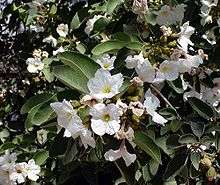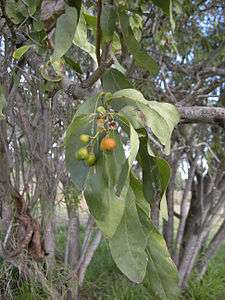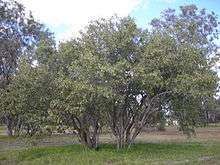Cordia
Cordia is a genus of flowering plants in the borage family, Boraginaceae. It contains about 300 species of shrubs and trees, that are found worldwide, mostly in warmer regions. Many of the species are commonly called manjack, while bocote may refer to several Central American species in Spanish. The generic name honours German botanist and pharmacist Valerius Cordus (1515–1544).[3] Like most other Boraginaceae, the majority have trichomes (hairs) on the leaves.
| Cordia | |
|---|---|
 | |
| Cordia boissieri in bloom | |
| Scientific classification | |
| Kingdom: | Plantae |
| Clade: | Tracheophytes |
| Clade: | Angiosperms |
| Clade: | Eudicots |
| Clade: | Asterids |
| Order: | Boraginales |
| Family: | Boraginaceae |
| Subfamily: | Cordioideae |
| Genus: | Cordia L. |
| Type species | |
| Cordia myxa L.[1] | |
| Species | |
|
See text | |
| Synonyms | |
|
Cerdana Ruiz & Pav. | |
Taxonomy
The taxonomy of Cordia is complex and controversial. Gottschling et al. (2005) say this is partly due to "extraordinarily high intraspecific variability" in some groups of species, making identification difficult, and partly due to new taxa having been "airily described on the basis of poorly preserved herbarium specimens".[4]
Selected species
- Cordia africana Lam. – White manjack
- Cordia alliodora (Ruiz & Pav.) Oken – Spanish elm, Ecuador laurel, salmwood, bocote (Neotropics)[5]
- Cordia boissieri A.DC. – Anacahuita, Texas olive (southern Texas, Northern Mexico)
- Cordia curassavica (Jacq.) Roem. & Schult. – Black sage, wild sage
- Cordia dentata Poir. – White manjack
- Cordia dichotoma G.Forst – Fragrant manjack, bird lime tree (Tropical Asia and Australasia)[6]
- Cordia leucophlyctis Hook f. – (endemic to the Galápagos Islands)
- Cordia lutea Lam. – Yellow cordia (western South America, including the Galápagos Islands)
- Cordia monoica
- Cordia myxa L. – Assyrian plum (South Asia)
Cordia domestica is treated as a separate species by some sources, and as C. myxa var. domestica by others.[7] Cordia obliqua Willd. (the clammy cherry) has been placed in the "Cordia myxa complex",[8] or treated as a synonym for Cordia dichotoma.[9] - Cordia platythyrsa Baker
- Cordia rupicola Urban – Puerto Rico manjack (Puerto Rico)
- Cordia sebestena L. – Geiger tree, large-leaf Geigertree (southern Florida, Greater Antilles, Central America)
- Cordia sinensis Lam. (=C. gharaf) – Grey-leafed saucerberry
- Cordia subcordata Lam. – Kou, tou, marer (Africa, South Asia, Southeast Asia, northern Australia, Pacific Islands)
- Cordia sulcata DC. – Mucilage manjack,
laylay, white manjack, wild clammy cherry
Formerly placed here
- Carmona retusa (Vahl) Masam. (as C. retusa Vahl)[10]
Ecology
Cordia species are used as food plants by the caterpillars of some Lepidoptera species, such as Endoclita malabaricus, Bucculatrix caribbea, and Bucculatrix cordiaella.[11] The wild olive tortoise beetle (Physonota alutacea) feeds on C. boissieri, C. dentata, C. inermis, and C. macrostachya.[12]
Uses
Ornamental
Many cordias have fragrant, showy flowers and are popular in gardens, although they are not especially hardy.[13]
As food
A number of the tropical species have edible fruits, known by a wide variety of names including clammy cherries, glue berries, sebesten, or snotty gobbles. In India, the fruits of local species are used as a vegetable, raw, cooked, or pickled, and are known by many names, including lasora in Hindi. One such species is fragrant manjack (C. dichotoma), which is called gunda or tenti dela in Hindi and lasura in Nepali. The fruit of the Fragrant Manjack is called phoà-pò·-chí (破布子), 樹子仔, or 樹子(Pe̍h-ōe-jī: chhiū-chí) in Taiwan where they are eaten pickled.
Glue
The white, gooey inner pulp of the fruits is traditionally used to make glue.
Wood
The wood of several Cordia species is commercially harvested. Ecuador laurel (C. alliodora), ziricote (C. dodecandra), Spanish elm (C. gerascanthus), and C. goeldiana are used to make furniture and doors in Central and South America.[13]
Ziricote[14] and bocote[15] are sometimes used as tonewoods for making the backs and sides of high-end acoustic guitars such as the Richard Thompson signature model from Lowden.[16] Similarly, drums are made from C. abyssinica, C. millenii, and C. platythyrsa due to the resonance of the wood.[17]
Gallery
 C. sinensis foliage and fruit.
C. sinensis foliage and fruit. C. sinensis trees.
C. sinensis trees.- Fruits of Cordia goetzei
References
| Wikimedia Commons has media related to Cordia. |
| Wikispecies has information related to Cordia |
- "Cordia L." TROPICOS. Missouri Botanical Garden. Retrieved 2009-10-20.
- "Cordia L." Germplasm Resources Information Network. United States Department of Agriculture. 2007-10-05. Retrieved 2010-03-01.
- Quattrocchi, Umberto (2000). CRC World Dictionary of Plant Names: A-C. CRC Press. pp. 612–613. ISBN 978-0-8493-2675-2.
- Gottschling, Marc; Miller, James S.; Weigend, Maximilian & Hilger, Hartmut H. (2005-10-01). "Congruence of a Phylogeny of Cordiaceae (Boraginales) Inferred from ITS1 Sequence Data with Morphology, Ecology, and Biogeography". Annals of the Missouri Botanical Garden. 92 (3): 425–437. JSTOR 40035480.
- Grandtner, Miroslav M. (2005). Elsevier's Dictionary of Trees. 1. Elsevier. pp. 252–260. ISBN 978-0-444-51784-5.
- "Cordia dichotoma Forst. f." Ecology and Evolutionary Biology Plant Growth Facilities. University of Connecticut. 2009-10-06. Archived from the original on 2008-05-15. Retrieved 2009-10-20.
- "Cordia domestica". The Plant List. Retrieved 2015-06-26.
- "Cordia obliqua". Germplasm Resources Information Network (GRIN). Agricultural Research Service (ARS), United States Department of Agriculture (USDA). Retrieved 2015-06-26.
- "Cordia obliqua". The Plant List. Retrieved 2015-06-26.
- "Species Records of Cordia". Germplasm Resources Information Network. United States Department of Agriculture. Retrieved 2010-08-21.
- Davis, Donald R.; Bernard Landry; Lazaro Roque-albelo (2002). "Two new Neotropical species of Bucculatrix leaf miners (Lepidoptera: Bucculatricidae) reared from Cordia (Boraginaceae)". Revue Suisse de Zoologie. 109 (2): 277–294. doi:10.5962/bhl.part.79591.
- Quinn, Mike. "Wild Olive Tortoise Beetle Physonota alutacea Boheman, 1854". Texas Beetle Information. Texas Entomology. Retrieved 2010-04-05.
- Bennett, Masha (2003). Pulmonarias and the Borage Family. Timber Press. pp. 196–198. ISBN 978-0-88192-589-0.
- http://www.lmii.com/CartTwo/thirdproducts.asp?CategoryName=+Backs+and+Sides&NameProdHeader=Ziricote Luthiers Mercantile page about Ziricote
- http://www.lmii.com/CartTwo/thirdproducts.asp?CategoryName=+Backs+and+Sides&NameProdHeader=Bocote Luthiers Mercantile page about Ziricote
- Presad, Anil (October 2009). "Richard Thompson" (PDF). Guitar Player: 50. Archived from the original (PDF) on 2011-06-10.
- Tudge, Colin (2007). The Tree. Random House. p. 237. ISBN 978-0-307-39539-9.